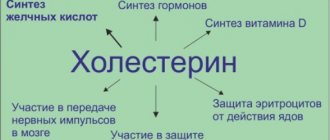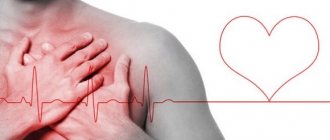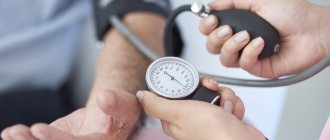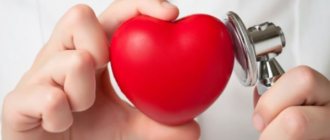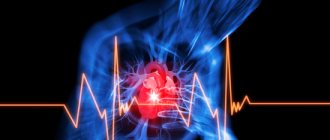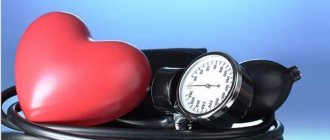The popular belief that cholesterol is harmful to health is not entirely true. On the contrary, it is necessary to ensure some vital processes in the body.
Only about 20% of this substance comes with food, and 80% is synthesized by the liver. Of interest is the opinion of the famous doctor and host of the popular medical program Dr. Myasnikov about cholesterol and statins. It is known that he himself has been taking these drugs for a long time to prevent atherosclerosis.
Mechanism of action of statins
Statins block the enzyme HMG-CoA reductase, which triggers sterol synthesis.
Therefore, another name for the drugs is HMG-CoA reductase inhibitors. Reducing the amount of synthesized cholesterol forces the body to look for alternative sources of its production. The simplest of them is the absorption of sterol from food. Therefore, during treatment, the patient must adhere to a diet that limits the intake of cholesterol into the body. Otherwise, the need to launch other compensatory mechanisms disappears.
The second most difficult is the breakdown of LDL. Under the influence of statins, receptors on the surface of the liver are activated that capture LDL and extract cholesterol. The second source of sterol production is atherosclerotic plaques, tissues containing it. To deliver cholesterol to the liver, additional amounts of HDL are synthesized.
Reducing the level of cholesterol, LDL, triglycerides, increasing the content of HDL inhibits the progression of atherosclerosis. Consequently, the likelihood of developing complications that it provokes is reduced: coronary heart disease, stroke, myocardial infarction, limb necrosis.
The benefits of statins are not limited to their effect on lipid metabolism. Taking them improves the condition of the vessel wall, reduces blood viscosity, and helps relax the muscular lining of the artery.
The harm of statins is not denied by drug manufacturers and health authorities. But its reasons are unclear. There are several theories to explain the side effects of medications:
- disruption of the oxidation of fatty acids;
- mitochondrial dysfunction;
- autoimmune reactions;
- damage to cell membranes (this includes cholesterol);
- activation of pathological processes to which a person is predisposed;
- reduction in coenzyme Q10 content.
On the issue of the safety of statins. Facts, comments
Report and discussion on the safety of statin treatment. Speaker - Oksana Mikhailovna Drapkina .
00:00
Susekov Andrey Vladimirovich , Doctor of Medical Sciences, Professor:
— Let me, remaining within the rules, offer the floor for the next report. The report is interesting. On the issue of the safety of statins. Facts, comments. Please, Oksana Mikhailovna.
While she begins my short remark, how ready are we to discuss the safety of statins. Still ready. In February 2012, when the whole world is actively healing, there is probably such a need.
Drapkina Oksana Mikhailovna , executive director of the Internet session, secretary of the interdepartmental council on therapy of the Russian Academy of Medical Sciences:
- Yes, if it is in demand, it means there is such a need.
Heroes of our time. These are people, historical figures. This is a large hadron collider that accelerates particles to some absolutely incredible rates. This is still the oyster mushroom, from which the first statin was obtained.
I will not talk about the fact that mortality is high, that people die from cardiovascular complications, that this is almost every second resident of Russia. Statins are needed, statins prolong life and improve its quality. This is undeniable.
Security issue. When statins are used (we know this mechanism very well), the production of mevalonate is reduced through a series of transformations. But for us the most important thing is the goal. The main goal is to reduce total cholesterol (TC) levels. But it's not that simple.
On the way to this goal, we simultaneously do a lot of things along the way. We reduce isoprenoids, ubiquinone, lipid-bound proteins, steroid and sex hormones. It changes a little, modifying the synthesis of vitamin D hormone, bile acids, and so on. There are by-products in this chain. These byproducts primarily serve as sites where the unwanted effects of statins can occur.
Which? We know (clinicians) that patients came to us who complained, for example, of muscle problems due to high doses of various statins. Where to look for the cause of these problems. Possibly a decrease in ubiquinone.
Please note, dear colleagues, that everything is a question mark for me, because there is no exact evidence for this. An increase in transaminase levels and an effect on liver damage - perhaps this solution lies in a decrease in the level of glutathione and cholesterol. This appears to underlie some cognitive dysfunctions. Although many studies say that cognitive function does not improve with statins.
Pancreatic dysfunction, sexual dysfunction. Recently, the issue of insulin resistance has become most relevant, because there are still a lot of questions here. Although recent studies indicate that there is some increase in insulin resistance with the use of statins.
03:27
I will focus on the main problems proposed. I will try to give a literary review of what is now known about: first, statins and striated muscles. I'm moving into the area of statins and myopathy. I don't want to use the word rhabdomyolysis because it is a rare complication. Nevertheless, we need to know and talk about this.
Rhabdomyolysis, which is associated with statin use, is very rare. If we talk about statistics, less than one case in a million. Myopathies, that is, with an increase in the level of CPK, but something that has not yet led to randomyolysis, the frequency is different in different literary sources. On average, we can say one in 10 thousand. This occurs more often at high doses.
Next I will say that a statin, especially Simvastatin at a dose of 80 mg, is the dose that most often causes changes in the striated muscles. In this regard, the FDA does not recommend that we use Simvastatin 80 mg.
How can we prevent the possible consequences and possibility of this undesirable phenomenon. This is mainly seen in older, thinner patients. In patients with high doses of statins. Here again I can say more about what has been proven - this is symbol 80.
Early clinical diagnosis of rhabdomyolysis is possible. You just need to pay special attention to muscle pain without increasing CPK. Conduct tests or physical tests that we perform on patients with osteoporosis. A simple chair rise test. A simple test called “wake up and go”.
It is possible to assess the dynamics of muscle strength in patients. In 2010, the instructions for Simvastatin were revised. We must understand that some research was to blame. In particular, the FDA cited the Search study, which used Simva at a dose of 80 mg. Here myopathy developed somewhat more often. We take this dosage with a little suspicion.
I don’t know whether my respected chairman of our symposium, Professor Susekov, Professor Gurevich, will agree with me. We can never prescribe a dose of 80 mg of Simvastatin at the moment, or are there still situations when we will do this?
06:28
Andrey Susekov : If I remember the instructions correctly, there is the following phrase: “Those patients who go on 80 mg, they can continue. But it is advisable to remove new appointments.”
In addition, we understand that this study, which is designed to include a large group of 80 mg Simvastatin, is ongoing. Consequently, additional experience accumulates.
You're probably absolutely right. I believe there are two statins left for high doses - Atorvastatin 80 mg and Rosuvastatin 40 mg.
Oksana Drapkina : I think that Viktor Savelyevich at the end of the lecture, when we have a discussion, will also express his opinion on this matter.
I will continue my lecture. We looked at the issue of myotoxicity. Factors that predispose to the development of statin-associated myopathy are:
- - old age (over 70 years old);
- — “fragile” patients (usually women);
- - polymorbid patients. Here again the question of the normal functioning of cytochrome P-450 and its various isoforms is raised. One isoform, for example, is subject to very high expectations and pressures.
- - perioperative period. They are still arguing. After coronary artery bypass surgery, we know as an axiom: the sooner you give a statin, the better. It must be given as early as possible.
But sometimes during the perioperative period there is evidence when the level of cholesterol sharply decreases due to stress or for some other reason. Publications appear on when to give, despite low cholesterol levels, or not to give, wait. I propose to discuss this during the discussion:
- — organ transplantation;
- - a lot of drugs.
08:26
It would seem that the tasty, harmless, at first glance, Pacha Monaco cocktail, loved by many, if used regularly, can unwittingly cause an increase in the concentration of any drug. Including statins. Grapefruit causes, through its effect on cytochrome P-450, such prochostatic manifestations in the liver, which sometimes happens when using statins (Verapamil, etc.).
Perhaps the reason is that the natural production of ubiquinone, Co-enzyme Q10, which serves as the main mitochondrial antioxidant, is reduced. It is especially necessary for muscles. Muscles are especially sensitive to a deficiency of Co-enzyme Q10.
The decrease in ubiquinone concentration in the blood occurs parallel to the statin dose. The question remains open whether it is worth adding Co-Enzyme Q10 or not. In what doses and what should be the prerequisites for this purpose.
New mechanisms of myotoxicity have also been discovered. This inhibition of protein prenylation triggers myocyte apoptosis. These are immune-mediated necrotizing myopathies, that is, features of polymyositis. Or atrogin-1 induction. It serves as a major factor in muscle protein ubiquinone deficiency. This leads to atrophy. Such phenomena are also observed.
What to do. The principles of management of patients with myopathy are different. To start the discussion:
- — addition of ubiquinone and vitamin D;
- - reducing the statin dose;
- — application “every other day” (possible or not – I asked Western experts several times);
- — if it is a long-acting statin, how much its dosage can be changed.
10:37
Next question. Statins and carbohydrate metabolism disorders. Early studies showed benefits in a group of patients with diabetes mellitus (DM) during statin therapy. I will refer or draw your attention again to the past.
This is a study using Pravastatin 40 mg versus placebo. There was definitely no increase. In the case of diabetes, on the contrary, a reduction in the risk of developing new cases of diabetes was demonstrated.
A meta-analysis, which included almost 40 thousand patients, also revealed virtually no risk of increased diabetes. But here it must be said that this meta-analysis did not include the results of the Jupiter study, which for the first time quite accurately and clearly showed an increase in the incidence of diabetes in patients using Rosuvastatin.
Let me remind you of the Jupiter study. It involved healthy men and women without risk factors. The only focus was on the level of high-sensitivity C-reactive protein, which was more than 2 mg/L. These apparently healthy men and women received Rosuvastatin 20 mg or placebo for almost two years.
The results were very impressive. The level of low-density lipoprotein cholesterol (LDL) decreased. The level of C-reactive protein decreased. This indirectly indicates the pleiotropic or anti-inflammatory effects of statins.
The complete safety of Rosuvastatin 20 mg was clearly demonstrated in this study. If you compare and see what it looked like, there were 1,377 cases of some side effects with placebo, and with Rosuvastatin 20 mg there were 1,352 cases.
Of course, there was no statistically significant significance in favor of Rosuvastatin, but this is a very good result. Compared to placebo, it is no worse in terms of safety.
"Rosuvastatin" began to go and spread widely. It always happens that when a statin is good, when it has proven its effectiveness, high-quality generics appear. Today we say that there is such a generic.
Why can we talk about quality? There is data that suggests the bioequivalence of the original Rosuvastatin. This is the drug "Mertinil". Although we need to gain experience in using this generic drug. So far it's a promising start. But then we need to see what will happen and how it will be proven.
13:47
We return to the issue of diabetes, which first arose against the background of the use of Rosuvastatin. After the results of the study were calculated, it turned out that the difference between the two groups: placebo and the group using Rosuvastatin was statistically significant.
Was this only with Rosuvastatin? No, not only. For the first time they started talking about increasing the DM on Atorvastatin. These data were also observed against the background of the use of Simvastatin.
Thus, we can conclude that this is still a class of effect statins, which does not change depending on the location in the membrane and the hydro- or lipophilicity of the statin, metabolism. Some statins are metabolized through various isoforms of cytochrome P-450, either 3A4 or 2C19. Does not depend on the activity and half-life of a particular statin.
The mechanisms of development of diabetes are quite complex. Possible disturbances in glucose metabolism due to statins. This is a pancreatic cell. Glucose enters the beta cell of the pancreas through the Glut-2 transporter. It is then phosphorylated by glucokinase to glucose-6-phosphate. It then undergoes a cascade of reactions that ends in the mitochondria with the release of ATP.
The release of ATP causes the ATP-gated potassium channel to open. Potassium comes out of the tap hole. This leads to the opening of the calcium channel. Calcium enters the cell. In the presence of calcium, insulin secretion occurs. When statins inhibit this pathway, insulin secretion decreases.
Next mechanism. Its end point is also a decrease in ATP production. But statins take a different route to this reduction in ATP production, affecting ubiquinone, an essential component of the mitochondrial electron transport chain.
16:06
Again the same scheme. ATP production decreases. Under conditions of decreased ATP production, insulin secretion by beta cells decreases.
Glucose transporters in adipocytes Glut-4 also changes when using statins. There is evidence that statins suppress the expression of the glucose transporter genes Glut-4 in adipocytes.
Why? If we remember how they act on the cholesterol synthesis cascade, then the amount of isoprenoids also decreases with the use of statins. This serves as a change in the expression of the glucose transporter genes Glut-4 in adipocytes.
The last scheme. We've taken apart the lower part of the beta cell of the pancreas. It turns out that cholesterol itself negatively affects glucokinase, an enzyme that mediates the entire cascade of mechanisms that ends with the opening of the ATP-dependent potassium channel. This slightly reduces insulin secretion.
Possible discussions are described, such as the oxidation of LDL cholesterol. They lead to activation of the intracellular immune response. The inflammatory cascade is launched. There is evidence of cytokine-mediated hyperproduction of nitric oxide, which stimulates beta cell apoptosis through activation of calcium-dependent protease.
Here's what I've found so far. But does this mean that we will not use statins for fear of insulin resistance? Of course not. Statins for already developed diabetes are an absolutely necessary component of therapy. When the risks and benefits were calculated, it turned out that it was necessary to use statins for 4 years in 255 people so that only one would develop diabetes. This prevents a large number of deaths or myocardial infarctions.
Thus, the opinion of experts is clear. The effectiveness of statins is higher than the risk. The benefits of statins relative to the risk are estimated to be 9:1. We will use statins, knowing that it is necessary to monitor the level of glucose and glycosylated hemoglobin.
19:07
The last thing I need to point out is. The word “hepatotoxicity” is crossed out. We should say: “Effect of statins on liver function.” I'll be brief here.
Statins are used for chronic liver diseases with little or no caution. This is non-alcoholic fatty liver disease (NAFLD) as a new predictor of cardiovascular disease (CVD), altering thrombus kinetics and serving as a predictor of CVD.
As my teacher, Academician Ivashkin, says: “What is good for the heart is also good for the liver.” I have heard this phrase for 10 years. Back then, no one could have predicted that statins would be good for the liver.
Now there is practical confirmation of this at all stages. At the stage of molecular mechanisms - the influence on the metabolism of the gene, which is responsible for the progression of fibrosis and the reparative mechanism. At the clinical level, after a very elegant work by Calazani, who divided the patients into three groups. Proved that the use of statins protected the liver from increased levels of ALT and AST.
After that there was a lot of work. I will refer to only one. Increases in serum transaminase were observed significantly less often in patients who protected their liver with statins compared to those who did not protect their liver with statins.
This does not limit the use of statins in chronic liver diseases. Statins are not contraindicated in the treatment of chronic hepatitis C. We are not talking about acute hepatitis. Statins reduce the risk of developing hepatocellular carcinoma. There are also many publications. They may even be useful in liver transplantation due to the possible reduction in the risk of developing infectious complications that affect the biliary tract.
Acute liver failure while taking statins is an extremely rare situation.
The hydrophilicity of Rosuvastatin is important in terms of safety.
Corona Study. One patient was 101 years old even with heart failure. They took Rosuvastatin. The incidence of side effects was also comparable to placebo in this study.
Even in pregnant women, there are already studies that talk about the use of statins during the first trimester of pregnancy. There were no side effects. The development of fetal defects has not been shown.
Thus, statins have probably not yet achieved the highest safety rating. The highest car safety rating was awarded to the Volvo XC 90 by the American Insurance Institute for Highway Safety.
The people who are involved in the production of these machines and the improvement of the safety system are constantly testing and testing new hypotheses.
I think that we should not lag behind this either. The safety of statins will be studied.
Thank you.
23:07
general information
Drugs from the statin group appeared due to the fact that the entire scientific world is struggling with high levels of cholesterol in the blood. Most people are sure: if their cholesterol has increased, this means that after some time atherosclerotic plaques must form. This is not an entirely correct opinion.
It should be noted that cholesterol level and the number of plaques in the blood are two completely non-linear relationships. Dr. Shishonin notes that there is no need to be afraid of cholesterol. In the video “Secrets of Treatment of Atherosclerosis,” the author reveals the whole truth about cholesterol.
Additionally, if you become a member
"Club of former hypertensive patients"
, you can find a lot of other interesting and, most importantly, healthy information. User registration is completely free.
To reduce blood cholesterol, it is customary to prescribe statins in medicine. What is their mechanism of action and are they harmful to health? Answers to these and other questions will be presented below.
So, cholesterol is a fat that is synthesized in all cells of our body, but the factory for the production of this substance is located in the liver. Cholesterol is used by the body to build cell membranes, for the biosynthesis of bile, group D vitamins and steroid hormones (androsterone, androstenedione, dehydrotestosterone, estradiol, estrone, estriol, etc.).
Taking into account the mechanism of cholesterol formation, scientists (pharmacologists, biochemists) decided to influence liver cells so that they stop synthesizing huge amounts of this substance. They started using statins to reduce cholesterol production. These medications break the metabolic chain of formation of this substance. All this negatively affects the functioning of the liver.
Indications for prescribing statins
The benefits of statins have been proven for patients who do not respond to diet therapy for:
- familial homo-, heterozygous hypercholesterolemia;
- combined hypercholesterolemia;
- dysbetalipoproteinemia;
- hypertriglyceridemia.
Certain drugs in the group are indicated for children with hereditary homozygous hypercholesterolemia. This is a severe genetic abnormality in which cholesterol levels are high regardless of diet. Patients with homozygous hypercholesterolemia are at risk of developing very early coronary heart disease and myocardial infarction.
Taking statins is harmful to the body if the drug is prescribed to people who do not need it. There is no doubt that medications are really effective in preventing complications of atherosclerosis and recurrent heart attack/stroke. What is fundamentally controversial is not the prescription of statins, but the patient selection criteria and dosage. Lists of recommendations are regularly reviewed and adjusted in accordance with new research results.
Statins are indicated for people:
- having cardiovascular diseases;
- LDL level above 190 mg/dl;
- people 40-75 years old with type 2 diabetes mellitus;
- people 40-75 years old with ≥7.5% 10-year risk of developing cardiovascular disease.
When calculating the risk of cardiovascular diseases, the following are taken into account:
- floor;
- age;
- race;
- total cholesterol level, LDL;
- systolic pressure indicators;
- whether the patient is taking medications to lower blood pressure;
- presence of diabetes;
- whether the person smokes or not.
Statins:
- taken exclusively in conjunction with diet;
- require compliance with the dosage regimen;
- accompanied by regular blood tests;
- are appointed for life. The effectiveness of statin therapy courses has not been proven.
In what cases are they prescribed?
Indications for prescribing statins are combined into 2 groups: absolute and relative. Absolute medications require the mandatory use of these medications to normalize the patient’s condition. Relative conditions include conditions when these drugs can be replaced with other medications or diet therapy. For some categories of patients, refusal to take statins can lead to severe complications and even death.
Absolute indications include:
- cholesterol levels exceed 10 mmol/l;
- persistent hypercholesterolemia after 3 months of a therapeutic diet;
- family predisposition to increased production of low-density lipoproteins;
- the presence of pronounced signs of atherosclerosis;
- lipid metabolism disorder;
- coronary heart disease with a high risk of heart attack and stroke;
- abdominal aortic aneurysm;
- coronary artery stenosis;
- diabetes mellitus in combination with coronary heart disease;
- a history of stroke or heart attack.
No ads 3
The absolute indication for the prescription of these drugs is an increased level of cholesterol in the blood, namely if the total level exceeds 6 mmol/l, and low-density lipoproteins - more than 3 mmol/l. However, the prescription of statins is purely individual. So, in some cases it is necessary to take statins even at lower levels, but there are many risk factors.
The relative nature of the indications means that it is advisable to take statins, but you can try diet therapy instead of medications. This tactic is applicable in the following cases:
- a history of unstable angina;
- sudden death of a close relative under 50 years of age from heart disease;
- low risk of heart attack;
- diabetes;
- obesity;
- reaching 40 years of age with an existing risk of developing pathologies of the cardiovascular system.
According to general standards, elevated cholesterol levels, but the absence of a risk of developing cardiovascular pathologies, are not sufficient grounds for prescribing statins. But the advisability of taking these drugs is assessed by the attending physician in each specific case, taking into account chronic and hereditary diseases.
Only the doctor determines which statins a particular patient can and should take. Doctor Myasnikov’s opinion on the prescription of statins is as follows: the presence of risk factors, for example, obesity and diabetes mellitus, and a cholesterol level of 5.5 mmol/l is the basis for taking them.
Some pathologies cannot be avoided without taking statins.
The harm of statins
Why are statins dangerous? Like most drugs, drugs in this group have a number of side effects and contraindications for use. Most are mild and can be lived with given the potential benefits. The danger is that severe adverse reactions often develop after years of taking the drugs.
The frequency of side effects indicated in the instructions differs to a lesser extent from the number of real complaints. The reason for the discrepancy is the careful selection of patients for the clinical trial. Typically, people with kidney failure, liver failure, a history of myalgia, severe diabetes mellitus, and taking medications that can interact with HMG-CoA reductase inhibitors are excluded from it.
The most common harmful side effects of statins are muscle problems. The reason for their occurrence is unknown. A pattern has been identified between intense physical activity and serious muscle complications. About 25% of athletes taking statins report muscle pain and spasms.
The most common adverse reaction is myalgia (muscle pain). It affects 5-7% of patients.
Myopathy is a fairly rare complication of statins. It develops in 5 people out of 100,000. The severity of myopathy varies: from increased creatine kinase activity with or without myalgia, weakness to muscle breakdown (rhabdomyolysis). Cases of the latter are fortunately rare - 0.44-0.54 cases/10,000 people per year.
The harm of statins to the digestive system is negligible. Taking most medications is accompanied by flatulence, gastrointestinal discomfort, constipation and/or diarrhea.
Taking statins is often accompanied by an increase in the level of liver amylases: ALT, AST. High activity of these enzymes is associated with liver damage. But in fact, they speak of hepatotoxicity when 3 factors coincide:
- increase in ALT, AST ≥3 times;
- increased concentration of total bilirubin (≥ 2 times);
- there are no other causes of changes in blood biochemistry (cholestasis, infectious hepatitis, taking a drug toxic to the liver).
An isolated increase in the enzyme is characteristic of several diseases. They must be excluded before drawing conclusions about the medicinal nature of the pathology.
The harmful effects of statins on the fetus were tested in laboratory animals. Rats whose mothers were given HMG-CoA reductase inhibitors were born with developmental defects, which is predictable. Cholesterol is necessary for the normal formation of the fetus. The body of pregnant women even produces an increased amount of it. Blocking cholesterol synthesis disrupts embryo development.
No studies have been conducted on the effects of statins on the human fetus due to the large number of risks to the health of the unborn baby. Based on theoretical assumptions and experiments involving animals, the use of statins by pregnant women was prohibited.
When prescribing a drug to a woman of childbearing age, a doctor warns her about the need to use reliable contraceptives. An unplanned pregnancy will present her with a difficult choice: leave the baby, accepting possible pathologies, or have an abortion.
The harm caused by statins to the nervous system is widely discussed in the medical community. Indeed, while taking statins, memory impairment, peripheral neuropathy, depression, sensitivity, and sleep may develop.
When a possible relationship between drug use, amnesia, and dementia was discovered, this phenomenon began to be studied. The results obtained are quite controversial. There is a lot of data proving that statins reduce the risk of developing dementia, and taking them together with some antidepressant drugs allows you to overcome depression much faster.
The harm of statins has been proven in relation to the development of type 2 diabetes.
In addition to cholesterol synthesis, statins block the formation of coenzyme Q10. A lack of coenzyme leads to a deficiency of energy storage molecules. To provide the body with energy, the breakdown of additional glucose molecules is triggered. Sugar catabolism is carried out by the enzyme insulin, which begins to be synthesized in large quantities. Its consistently high concentration is addictive. Cells stop responding to it and assimilate glucose normally.
True, diabetes mellitus threatens those who have a predisposition to it:
- glucose level more than 5.6 mmol/l;
- BMI more than 30 kg/m2;
- triglyceridemia;
- hypertension.
Despite the possibility of developing diabetes mellitus, the benefits of taking statins outweigh the harms. Studies have shown that treating 250 people with statins for 4 years will provoke diabetes in one. At the same time, the use of drugs will prevent 5.4 deaths/250 people.
Other complications
During treatment with statins, vision may deteriorate. The most common complication is nebula, less often - bifurcation, cataract.
A hypothesis has also been put forward about the relationship between statin use and the development of cancer. It has been suggested that low cholesterol levels increase the risk of developing cancer. But this theory has not found sufficient evidence. On the contrary, data have emerged on the ability of statins to reduce the risk of developing prostate, stomach, and colon cancer.
The negative impact of statins on male sexual function is controversial. In a few patients, potency decreased during treatment. This may be due to general weakness and fatigue, which is accompanied by taking medications. However, some patients, on the contrary, note an improvement in erection since the start of treatment, which can be explained by an improvement in the condition of the blood vessels.
With long-term use of statins, side effects may occur:
- increased fatigue;
- muscle pain;
- dizziness;
- dysfunction of the digestive system;
- nausea and vomiting;
- rhabdomyolysis (destruction of muscle fibers);
- hyperglycemia;
- multiple sclerosis;
- vascular thrombosis;
- chills;
- myopathy;
- arthralgia;
- cataract;
- Alzheimer's disease;
- peripheral edema;
- jaundice;
- anorexia;
- pancreatitis;
- renal failure;
- skin rashes;
- persistent insomnia;
- flatulence;
- skin aging;
- blood clotting disorder;
- erectile disfunction;
- obesity;
- problems with memory and thinking;
- reactive cirrhosis.
Note. Dr. Shishonin notes that statins are a metabolic poison for the liver. Drugs from this pharmaceutical group, by interfering with deep biochemical processes, block natural reactions occurring in the liver. If these processes are disrupted, the physiological functions of the organ will not be restored soon. If possible, do not use statins, avoid them. Replace them with other substances, lead an active lifestyle.
What are statins for?
Statins are lipid-lowering drugs that suppress the production of an enzyme that is involved in the synthesis of cholesterol by liver cells. Drugs of this type improve the condition of the damaged layer of blood vessels at the stage when it is still impossible to diagnose atherosclerosis, but cholesterol deposition is already beginning on the inner wall.
This is an early stage of the development of atherosclerosis. In addition, experts note the beneficial effects of statins on blood properties, in particular, its viscosity decreases. This, in turn, prevents the formation of blood clots and prevents them from attaching to cholesterol plaques. There are 4 generations of statins. In clinical practice, first-generation drugs are most common.
The active ingredients in them are lovastatin, pravastatin, rosuvastatin. These medicines are of natural origin, but this fact is not their advantage, since they are less effective and have a wider range of side effects. They are also low in cost. These include Cardiostatin, Sincard, Zocor, Vasilip, Holetar.
Second generation statins have a less aggressive effect on the body and have a longer lasting effect. The drug of this generation is Lescol Forte with the active substance fluvastatin. It reduces cholesterol levels by no more than 30%. The third generation of statins based on atorvastatin (Tulip, Atomax, Liprimar, Torvacard) have a complex effect:
- reduce low-density cholesterol levels;
- reduce the production of triglycerides;
- stimulates the growth of high-density lipids.
No ads 2
The latest, fourth generation statins are most effective. Their advantage is that they not only help reduce bad cholesterol, but also help increase high-density cholesterol. The latest generation statin is Rosuvastatin. However, they are not recommended for use by people with kidney pathologies. In addition, long-term use of these drugs can provoke the development of diabetes.
In addition to these, the following effects are expected from taking statins:
- reducing the volume of atherosclerotic plaque;
- suppression of cardiac muscle hypertrophy;
- anti-inflammatory effect on blood vessels.
Statins reduce bad cholesterol levels
Benefits of statins
Statins are considered very effective and relatively safe drugs. Their effect on the body has been studied much more fully than other drugs. The benefits that statins provide are difficult to overestimate. Medicines in this group:
- lower cholesterol levels - 23-42%, LDL 20-55%, triglycerides 5-10% or 15-30% (depending on the active substance), increase HDL concentration - 10-20%;
- reduce mortality – 17%;
- reduce the likelihood of cardiovascular deposits - 24%, myocardial infarction - 53%, stroke - 48%.
However, they should be prescribed with caution as they significantly alter metabolism.
What can replace statins and is there an alternative to them?
First you just need to stop taking them. Naturally, this must be done only under the supervision of the attending physician. It is necessary to gradually reduce the dose, as some drugs can be addictive. After determining the level of cholesterol in the blood, you can begin diet therapy.
With an irrational diet, the level of cholesterol in the blood will not normalize. If a person’s cholesterol increases when they stop taking statins, then this is not bad. If the patient adheres to the doctor’s recommendations, then after some time the level of this compound will stabilize.
To normalize blood cholesterol levels, you need to do physical exercise. You can start with squats. If you do them regularly, at least 50-60 times a day, you will achieve the desired result. Specialists at Doctor Shishonin’s Clinic point out that this method always works flawlessly.
Why does squatting lower cholesterol? The answer is simple. During squats, the most powerful muscles in our body work. To perform this work, the body must synthesize new muscle fibers, and for this it will need a lot of cholesterol, which is spent on building cellular biomembranes.
Elena Malysheva
Elena Malysheva is a Russian TV presenter of the “Health” and “Live Healthy” programs. She worked as a therapist for some time and defended her dissertation on cardiac arrhythmias. She was not a practicing doctor for long and after several years of work she became an assistant at the Department of Internal Medicine of the Russian State Medical University, where she still lectures from time to time.
The program “Live Healthy,” which airs on Channel One, has brought scandalous fame to the presenter, as frank topics are discussed on the morning broadcast.
Nutrition secrets
It is important that your diet contains high-quality fats. What is it for? First of all, this is necessary so that bile, which consists mainly of cholesterol, enters the duodenum through the ducts. Without bile, the process of emulsification and breakdown of fats will not occur.
If a person does not consume fats, then he will soon have problems with the functioning of the gallbladder and liver. This is discussed in Dr. Shishonin’s video “The Secret is in the Word Cholesterol.”
When eating fatty foods, bile flows into the duodenum. In this part of the intestine there are receptors that, when fatty foods enter, are excited, and the liver and bile ducts are stimulated, they contract, which leads to secretions entering the intestines.
Thus, the liver gets rid of accumulated cholesterol, sending it to the intestines. This is a very important physiological process that must be carried out daily. Eating high-quality dairy products (sour cream, cheese, cottage cheese, etc.) helps reduce cholesterol.
Doctor Myasnikov about cholesterol and statins
Cholesterol is solid bile or lipophilic alcohol. The organic compound is an integral part of cell membranes, which makes them more resistant to temperature changes. Without cholesterol, the production of vitamin D, bile acids and adrenal hormones is impossible
The human body produces approximately 80% of the substance itself, mainly in the liver. The remaining 20% of cholesterol comes from food.
Cholesterol can be good and bad. The chief physician of City Clinical Hospital N°71, Alexander Myasnikov, draws the attention of his patients to the fact that the beneficial or negative effect of a substance on the body depends on the density of the lipoproteins that make up the organic compound.
In a healthy person, the ratio of LDL to LDL should be equal. But if the levels of low-density lipoproteins are too high, then the latter begin to settle on the walls of blood vessels, leading to adverse consequences.
Doctor Myasnikov claims that levels of bad cholesterol will increase especially rapidly if the following risk factors are present:
- diabetes;
- hypertension;
- overweight;
- smoking;
- IHD;
- poor nutrition;
- vascular atherosclerosis.
Consequently, the primary cause of strokes and heart attacks around the world is an increase in the level of bad cholesterol in the blood. LDL is deposited on blood vessels, forming atherosclerotic plaques, which contribute to the formation of blood clots, which often leads to death.
Myasnikov also talks about cholesterol for women, that it is especially harmful after menopause. After all, before the onset of menopause, the intensive production of sex hormones protects the body from the appearance of atherosclerosis.
If cholesterol levels are high and the risks are low, drug treatment is not prescribed.
Statins are a leading group of drugs that help reduce harmful cholesterol to acceptable levels. These drugs significantly reduce the risk of developing cardiovascular diseases, although Dr. Myasnikov emphasizes to patients that medicine still does not know the exact principle of their action.
The scientific name of statins is HMG-CoA reductase inhibitors. They are a new group of drugs that can quickly lower LDL levels and increase life expectancy.
Presumably, the statin slows down the function of the liver enzyme that synthesizes cholesterol. The drug increases the number of LDL apolyprotein and HDL receptors in cells. Thanks to this, harmful cholesterol lags behind the vascular walls and is utilized.
Dr. Myasnikov knows quite a bit about cholesterol and statins, since he himself has been taking them for many years. The doctor claims that in addition to their lipid-lowering effect, liver enzyme inhibitors are highly valued due to their positive effects on blood vessels:
- stabilize plaques, reducing the risk of their rupture;
- eliminate inflammation in the arteries;
- have an anti-ischemic effect;
- improve fibirinolysis;
- strengthen the vascular epithelium;
- have an antiplatelet effect.
In addition to reducing the likelihood of developing diseases of the cardiovascular system, the benefit of statins is to prevent the occurrence of osteoporosis and intestinal cancer. HMG-CoA reductase inhibitors prevent the formation of gallstones and normalize kidney function.
Doctor Myasnikov draws attention to the fact that statins are very useful for men. The drugs help with erectile dysfunction.
All statins are available in tablet form. They are taken once a day before bedtime.
But before taking statins, you should take urine and blood tests and do a lipid profile to detect disorders in fat metabolism. In severe forms of hypercholesterolemia, you will need to take statins for several years or throughout your life.
| Generation | Features of the drugs | Popular products from this group |
| I | Made from penicillin mushrooms. Reduce LDL by 25-30%. They have a significant number of side effects. | Lipostat, Simvastatin, Lovastatin |
| II | Inhibits the process of enzyme release. Reduce total cholesterol concentration by 30-40%, can increase HDL by 20% | Leskol, Fluvastatin |
| III | Synthetic drugs are highly effective. Reduce total cholesterol by 47%, increase HDL levels by 15% | Novostat, Liprimar, Torvacard, Atoris |
| IV | Synthetic statins of the latest generation. Reduces bad cholesterol levels by 55%. Have a small number of adverse reactions | Rosuvastatin |
Despite the high effectiveness of statins for hypercholesterolemia, Dr. Myasnikov points out the likelihood of developing negative consequences after taking them. First of all, medications negatively affect the liver. Also, liver enzyme inhibitors in 10% of cases can affect the muscular system, sometimes contributing to the appearance of myositis.
There is an opinion that statins increase the risk of type 2 diabetes. However, Myasnikov is convinced that if you take the tablets in an average dosage, your glucose levels will rise only slightly. Moreover, for diabetics, vascular atherosclerosis, which leads to heart attacks and strokes, is much more dangerous than a minor disturbance in carbohydrate metabolism.
A number of studies have shown that in some cases statins impair memory and can change human behavior. Therefore, if such adverse reactions occur after taking statins, you should contact your doctor, who will adjust the dosage or discontinue use of the drug.
Taking statins brings both harm and benefit to the patient. These are serious drugs that require justified prescription. The risks of taking medications are much less than the potential benefits. This is confirmed by research results. While taking statins:
- the risk of heart attack and stroke is reduced by 50%;
- the number of patients requiring vascular operations is reduced;
- the risk of developing venous thrombosis is reduced by 15-25%;
- in patients with chronic obstructive pulmonary disease, mortality, the number of exacerbations, and hospitalizations are reduced;
- rosuvastatin reduces the likelihood of contrast-induced nephropathy in diabetes mellitus and chronic renal failure. This drug accelerates recovery from traumatic brain injuries.
You can watch a short video by Dr. Myasnikov, “Statins for cholesterol: harm and benefit,” in which the specialist explains the basic concepts very clearly.
Who is Alexander Myasnikov
Alexander Leonidovich Myasnikov was born into a family of hereditary doctors and graduated from the N. I. Pirogov Medical Institute. Then he successfully completed graduate school and defended his dissertation for the title of Candidate of Medical Sciences. Dr. Myasnikov is a cardiologist and general practitioner. At different times of his life he practiced medicine in the USA, France, and a number of African countries.
Today Alexander heads the city clinical hospital named after M. E. Zhadkevich in Moscow. He also hosts the program “About the Most Important Thing” and often appears on the radio, speaking in clear language about diseases common in modern society.
“Natural” analogues of statins
Natural statins are foods and herbs that contain substances that help lower sterol. By their nature, they are not HMG-CoA reductase inhibitors, but have similar properties. The only exception is red yeast rice. It contains lovastatin. If you are taking statins, eliminate this product from your diet. An overdose of statins is fraught with complications.
The following will help prevent the development of atherosclerosis, as well as slow its progression:
- cocoa;
- turmeric, basil, ginger, rosemary;
- oat bran;
- Cod liver;
- fish fat;
- flax seeds;
- Black tea;
- garlic;
- barley.
Herbal teas that help lower cholesterol:
- calendula;
- viburnum;
- alfalfa;
- raspberries;
- dandelion;
- licorice;
- linden color;
- thyme;
- rose hip;
- hawthorn berries.
There is a myth that naturally occurring statins do no harm. In fact, the therapeutic effect of plants is due to biologically active substances that require limited use and have side effects and contraindications. They may also interact with medications the patient is taking. Therefore, it is advisable to coordinate herbal treatment with your doctor.

